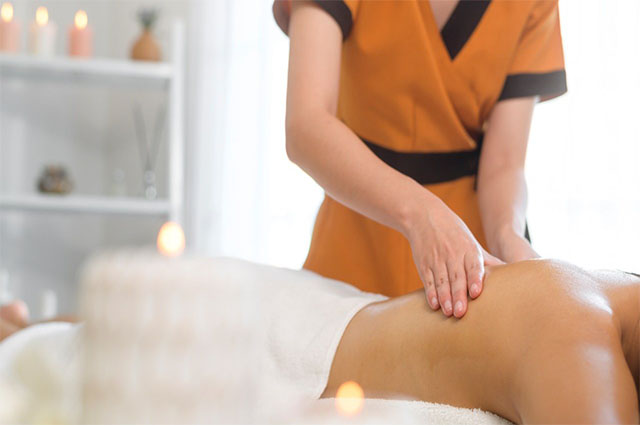
Of course! Let’s dive into the world of aromatherapy massage. It’s a popular and powerful holistic treatment that combines the physical benefits of massage with the psychological and physiological benefits of essential oils.
What is Aromatherapy Massage?
An aromatherapy massage is a form of therapeutic massage where specially chosen essential oils, extracted from plants, are blended with a carrier oil and applied to the body through touch.
The core principle is synergy: the massage relaxes the body and improves circulation, while the inhaled and absorbed essential oils work on the limbic system (the part of the brain that governs emotions, memories, and arousal). This creates a deeply relaxing and multi-layered healing experience that addresses both mind and body.
How It Works: The Two Pathways
- Through Smell (Olfactory System):
- When you inhale the scent of an essential oil, the odor molecules travel up the nose and are interpreted by the olfactory nerves.
- These nerves have a direct link to the limbic system, which is your brain’s emotional center. This is why smells can instantly trigger memories and powerfully affect your mood (e.g., calming you down or energizing you).
- Through the Skin (Absorption):
- During the massage, the essential oils, diluted in a carrier oil, are absorbed through the skin and into the bloodstream.
- The massage techniques themselves help to improve circulation, which aids in distributing the oils throughout the body.
Common Essential Oils and Their Benefits
A therapist will typically choose a blend based on your specific needs. Here are some common examples:
- For Relaxation & Stress Relief:
- Lavender: The classic calming oil, known for reducing anxiety and promoting sleep.
- Chamomile (Roman): Soothes nerves and eases tension.
- Bergamot: Uplifting yet calming, excellent for stress and sadness.
- For Energy & Uplifting Mood:
- Sweet Orange: Bright, cheerful, and energizing.
- Peppermint: Invigorating and clarifying, can also help with headaches.
- Rosemary: Stimulates the mind and improves focus.
- For Muscle Aches & Pain:
- Eucalyptus: Cooling, anti-inflammatory, and great for respiratory congestion.
- Marjoram: A natural muscle relaxant, often used for soreness and stiffness.
- Ginger: Warming, excellent for soothing inflamed joints and muscles.
- For Immune Support:
- Tea Tree: A powerful antiseptic and antimicrobial.
- Lemon: Cleansing and purifying, can boost the spirit.
What to Expect During a Session
- Consultation: A good therapist will always start with a consultation. They will ask about your physical health, stress levels, emotional state, and what you hope to achieve from the massage.
- Oil Blending: Based on the consultation, the therapist will select a blend of 2-4 essential oils and mix them with a neutral carrier oil (like sweet almond, jojoba, or grapeseed oil).
- The Massage: You will lie on a massage table, undressed to your level of comfort (covered by a sheet or towel). The therapist will use a variety of Swedish massage techniques, such as long gliding strokes and kneading, to apply the oil blend. The pressure can be light, medium, or firm, depending on your preference.
- The Experience: The room is often softly lit and quiet, with the gentle aroma of the oils filling the air. The combination of touch and scent is deeply immersive.
Potential Benefits of Aromatherapy Massage
The benefits are wide-ranging and can include:
- Reduced stress, anxiety, and depression
- Relief from muscle tension and pain
- Improved sleep quality
- Boosted immune system
- Enhanced mood and mental clarity
- Reduced severity of headaches
- Improved digestion
- Soothed skin (depending on the oils used)
Important Safety Considerations & Contraindications
Essential oils are highly concentrated and must be used with care.
- Never apply undiluted essential oils directly to the skin. They must always be mixed with a carrier oil.
- Allergies: Inform your therapist of any allergies or skin sensitivities.
- Pregnancy & Nursing: Many essential oils are not safe during pregnancy or breastfeeding. Always inform your therapist if you are pregnant, think you might be, or are nursing.
- Medical Conditions: If you have epilepsy, high blood pressure, cancer, or other serious health conditions, certain oils may be contraindicated. Full disclosure is essential.
- Photosensitivity: Some oils (especially citrus oils like bergamot and lemon) can make your skin sensitive to sunlight. Avoid sun exposure for 12-24 hours after using them.
- Quality: A professional therapist will use high-quality, pure essential oils, not synthetic fragrances.
Aromatherapy Massage vs. Regular Swedish Massage
| Feature | Aromatherapy Massage | Swedish Massage |
|---|---|---|
| Primary Focus | Holistic; addresses both mental/emotional and physical tension. | Primarily physical; focuses on muscle relaxation and circulation. |
| Key Component | Custom-blended essential oils. | Massage lubricant (often unscented lotion or oil). |
| Technique | Typically uses gentle to medium pressure Swedish techniques. | Uses a standard set of Swedish techniques (effleurage, petrissage, etc.). |
| Goal | To create a specific therapeutic effect (e.g., calm, energize) through scent and touch. | To relax muscles, improve range of motion, and promote general relaxation. |
In summary, an aromatherapy massage is a personalized, sensory journey that goes beyond simple muscle relaxation to promote deep emotional and physical well-being. If you’re looking for a massage that addresses how you feel both in your body and your mind, it is an excellent choice. Always seek a qualified and certified therapist for the best and safest experience.
